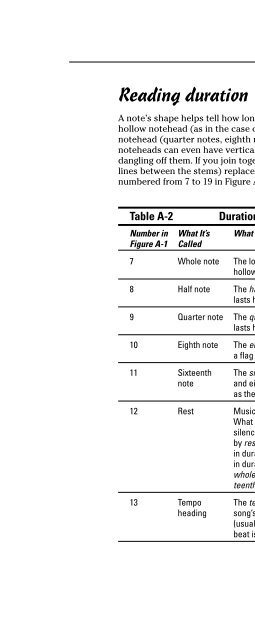238658923659
Appendix A: How to Read Music 335 Reading duration A note’s shape helps tell how long you need to hold it. Notes can have a hollow notehead (as in the case of the whole note and half note) or a solid notehead (quarter notes, eighth notes, and sixteenth notes), and the solid noteheads can even have vertical lines (called stems) with flags (curly lines) dangling off them. If you join together two or more notes, beams (horizontal lines between the stems) replace the flags. Table A-2 refers to the symbols numbered from 7 to 19 in Figure A-1. Table A-2 Number in What It’s What It Means Figure A-1 Called Duration Symbols and Their Meanings 7 Whole note The longest note is the whole note, which has a hollow oval head with no stem. 8 Half note The half note has a hollow oval head with a stem. It lasts half as long as the whole note. 9 Quarter note The quarter note has a solid oval head with a stem. It lasts half as long as the half note. 10 Eighth note The eighth note has a solid oval head with a stem and a flag or beam. It lasts half as long as a quarter note. 11 Sixteenth The sixteenth note has a solid oval head with a stem note and either two flags or two beams. It lasts half as long as the eighth note. 12 Rest Music consists not only of notes, but of silences, too. What makes music interesting is how the notes and silences interact. Silences in music are indicated by rests. The rest in Figure A-1 is a quarter rest, equal in duration to a quarter note. Other rests, also equal in duration to their corresponding notes, are the whole rest (W), half rest (H), eighth rest (E) and sixteenth rest (X). 13 Tempo The tempo heading tells you how fast or slow the heading song’s beat, or pulse, is. As you listen to music, you (usually) hear an immediately recognizable beat. The beat is what you tap your foot or snap your fingers to. (continued) TEAM LinG
- Page 652: Chapter 16: Changing Strings 309 Fi
- Page 656: Chapter 16: Changing Strings 311 Yo
- Page 660: Chapter 16: Changing Strings 313 8.
- Page 664: Part VI The Part of Tens TEAM LinG
- Page 668: Chapter 17 Ten Blues Guitar Giants
- Page 672: Chapter 17: Ten Blues Guitar Giants
- Page 676: Chapter 18 Ten Great Blues Guitars
- Page 680: Chapter 18: Ten Great Blues Guitars
- Page 684: Chapter 19 Ten (Plus One) Must-Have
- Page 688: Chapter 19: Ten (Plus One) Must-Hav
- Page 692: Part VII Appendixes TEAM LinG
- Page 696: Appendix A How to Read Music Readin
- Page 700: Appendix A: How to Read Music 333 R
- Page 706: 336 Part VII: Appendixes TEAM LinG
- Page 710: 338 Part VII: Appendixes TEAM LinG
- Page 714: 340 Part VII: Appendixes TEAM LinG
- Page 718: 342 Part VII: Appendixes Using the
- Page 722: 344 Part VII: Appendixes TEAM LinG
- Page 726: 346 Part VII: Appendixes TEAM LinG
- Page 730: 348 Part VII: Appendixes TEAM LinG
- Page 734: 350 Blues Guitar For Dummies TEAM L
- Page 738: 352 Blues Guitar For Dummies TEAM L
- Page 742: 354 Blues Guitar For Dummies TEAM L
- Page 746: 356 Blues Guitar For Dummies TEAM L
- Page 750: 358 Blues Guitar For Dummies TEAM L
Appendix A: How to Read Music<br />
335<br />
Reading duration<br />
A note’s shape helps tell how long you need to hold it. Notes can have a<br />
hollow notehead (as in the case of the whole note and half note) or a solid<br />
notehead (quarter notes, eighth notes, and sixteenth notes), and the solid<br />
noteheads can even have vertical lines (called stems) with flags (curly lines)<br />
dangling off them. If you join together two or more notes, beams (horizontal<br />
lines between the stems) replace the flags. Table A-2 refers to the symbols<br />
numbered from 7 to 19 in Figure A-1.<br />
Table A-2<br />
Number in What It’s What It Means<br />
Figure A-1 Called<br />
Duration Symbols and Their Meanings<br />
7 Whole note The longest note is the whole note, which has a<br />
hollow oval head with no stem.<br />
8 Half note The half note has a hollow oval head with a stem. It<br />
lasts half as long as the whole note.<br />
9 Quarter note The quarter note has a solid oval head with a stem. It<br />
lasts half as long as the half note.<br />
10 Eighth note The eighth note has a solid oval head with a stem and<br />
a flag or beam. It lasts half as long as a quarter note.<br />
11 Sixteenth The sixteenth note has a solid oval head with a stem<br />
note and either two flags or two beams. It lasts half as long<br />
as the eighth note.<br />
12 Rest Music consists not only of notes, but of silences, too.<br />
What makes music interesting is how the notes and<br />
silences interact. Silences in music are indicated<br />
by rests. The rest in Figure A-1 is a quarter rest, equal<br />
in duration to a quarter note. Other rests, also equal<br />
in duration to their corresponding notes, are the<br />
whole rest (W), half rest (H), eighth rest (E) and sixteenth<br />
rest (X).<br />
13 Tempo The tempo heading tells you how fast or slow the<br />
heading song’s beat, or pulse, is. As you listen to music, you<br />
(usually) hear an immediately recognizable beat. The<br />
beat is what you tap your foot or snap your fingers to.<br />
(continued)<br />
TEAM LinG



